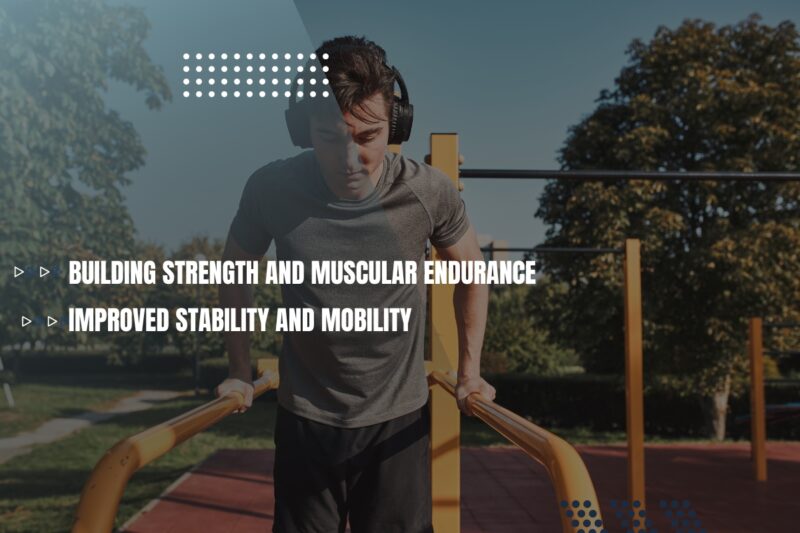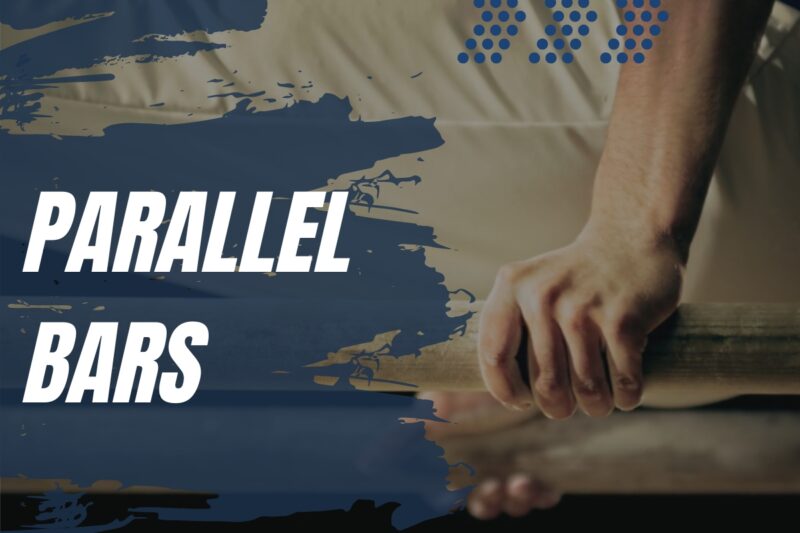Whether you’re a fitness novice, a gymnast, or a professional athlete, understanding the muscle groups you’re working on during any exercise can significantly enhance your physical development. In this post, we will delve into the impressive range of muscles that parallel bars exercise can target. Buckle up for an exciting journey into the fascinating world of anatomy and fitness.
Basic You Need to Know

Parallel bars are a pair of horizontal bars that are positioned at a similar height. These bars are widely used in gymnastics but have found their way into general fitness routines thanks to their versatility. Working out on parallel bars involves a myriad of movements that primarily use the body’s weight as resistance.
You may find different types of parallel bars in your local gym, varying in height and width. The selection is usually dependent on the type of exercise or training you plan to execute. High bars are typically used for advanced gymnastic maneuvers, while lower bars are perfect for beginners and strength training exercises.
Why Use Parallel Bars?
They can give you a challenging workout that can sculpt and tone your muscles like few other pieces of equipment can. Because they require you to manipulate your body weight, parallel bars target a variety of muscle groups simultaneously, providing a comprehensive workout.
Given the range of exercises that can be executed on the parallel bars, they allow for a versatile workout that can be tailored to your fitness level and goals. Whether you’re looking to develop upper body strength, core stability, or muscular endurance, parallel bars can facilitate your objective.
The Primary Muscle Groups Engaged

Now that we have a better understanding of parallel bars let’s look at the primary muscle groups that they engage. It’s important to recognize these muscles to ensure you are effectively targeting them during your workout.
The Upper Body
When using parallel bars, one of the most significant areas you’ll target is your upper body. The muscles engaged here include the chest, back, shoulders, and arms.
- The pectoralis major, the large muscle in your chest, plays a key role in allowing the movement of the shoulder joint.
- Your back muscles, particularly the latissimus dorsi, contribute to the extension, adduction, flexion, and rotation of the shoulder.
- The deltoids in your shoulders help with the abduction, flexion, and rotation of the shoulder.
- Your arm muscles, primarily the biceps and triceps, enable the flexion and extension of the elbow joint.
This comprehensive engagement of your upper body muscles makes parallel bars an ideal tool for enhancing upper body strength.
The Core
Your core muscles are also significantly engaged when using parallel bars. The rectus abdominis, obliques, and erector spine are the primary muscles at work here.
- The rectus abdominis, your ‘abs,’ plays a vital role in flexing the lumbar spine.
- The obliques, located on either side of your abs, help in rotating the trunk and flexing it sideways.
- The erector spinae, a set of muscles in your lower back, assists in the extension and rotation of the spine.
Performing exercises on this tool can help tone these muscles, promoting better balance and stability and enhancing your overall physical performance.
Popular Exercises
Now that we’ve covered the primary muscles engaged let’s take a look at some popular exercises performed on parallel bars. These exercises will show you how to leverage the bars to target specific muscle groups effectively.
Dips
Dips are among the most common exercises performed on parallel bars, primarily targeting your triceps, chest, and shoulder muscles. To perform dips:
- Start by gripping the bars and jumping up, keeping your body suspended and elbows locked.
- Lower your body slowly until your shoulders are below your elbows.
- Push your body back up to the starting position.
While dips mainly focus on your upper body, they also engage your core muscles, providing a well-rounded workout.
L-Sits
The L-Sit is a challenging exercise that focuses on your core muscles, although it also engages your triceps and hip flexors. To perform an L-Sit:
- Begin in the same position as you would for a dip.
- Extend your legs in front of you, keeping them as straight as possible. Your body should form an ‘L’ shape.
- Hold this position for as long as you can manage.
L-Sits require and improve your core strength and stability, contributing to better overall fitness.
The Benefits

Using parallel bars for workouts provides an array of benefits. They’re not just about building strength; these bars also improve stability, mobility and can contribute to better body control.
Building Strength and Muscular Endurance
As you’ve seen, parallel bars engage a broad range of muscles. Over time, using these bars can lead to significant strength gains. Additionally, performing high-repetition workouts on these bars can boost your muscular endurance, enhancing your ability to perform physical tasks over extended periods.
Improved Stability and Mobility
The diverse range of movements that you can perform on parallel bars helps improve your body’s overall stability. These exercises also improve joint mobility, particularly in your shoulders, elbows, and wrists, which are frequently engaged during workouts.
Parallel bars workouts are an excellent way to work on your balance and mobility while building strength and endurance. It’s no wonder that they’re a fixture in most gyms!
Precautions and Safety Tips

While parallel bars can be incredibly beneficial for fitness, it’s crucial to use them correctly to avoid injury. Let’s explore some precautions and safety tips.
Listen to Your Body
One of the most crucial aspects of using parallel bars is understanding and listening to your body. If you’re a beginner, it’s essential to start slow and gradually increase the intensity of your workouts. If at any point you feel pain or discomfort during a workout, stop and rest.
Use Proper Form
Maintaining proper form while performing exercises on parallel bars is vital. Improper form not only reduces the effectiveness of the workout but also increases your risk of injury. If you’re new to using it, consider seeking guidance from a trained professional to ensure your form is correct.
FAQs
What Muscles Do Parallel Bars Primarily Work?
They primarily work the triceps, chest, and shoulders. They also engage other arm muscles.
How Do Parallel Bars Benefit the Triceps?
They are an advanced variation of the tricep dip exercise. They help in strengthening and building muscle mass in the triceps.
What Impact Do Parallel Bars Have on The Chest Muscles?
They engage the chest muscles, specifically the pectoralis major, during the exercise. They help in strengthening and adding muscle mass to the chest.
Do Parallel Bars Work the Shoulder Muscles?
Yes, they work the anterior deltoid, which is the front part of the shoulder. This helps in strengthening the shoulders and improving their stability.
What Other Muscles Are Engaged?
Other muscles engaged when using them include the rhomboids, levator scapulae, latissimus dorsi, and lower trapezius. These muscles provide stability and aid in the proper execution of the exercise.
Are Parallel Bars Effective for Building Muscle Mass?
Yes, they are effective for building muscle mass, especially when additional weight is added to the exercise. They are a compound exercise that works for multiple muscle groups simultaneously, leading to greater muscle gains.
Can Parallel Bars Improve Athletic Performance?
Yes, they can improve athletic performance. They enhance overhead stability, which is essential for weightlifters during the top position of snatches or clean and jerks. They also work the triceps, which are involved in the final phase of lifting movements like the jerk, overhead press, bench press, and more.
What Are the Benefits for Beginners?
For beginners, they can be a bit challenging. However, there are numerous variations to meet specific skill levels. As one gets accustomed to the right form and gains strength, they can diversify from narrow or wide grip dips on the dip bar and use a weighted belt for added resistance.
Can Parallel Bars Be Used for A Full-Body Workout?
While they primarily target the upper body, they can be seen as a full-body workout because they also engage the back, chest, and even the core.
Can Parallel Bars Exercises Be Done Anywhere?
Yes, these exercises can be done anywhere as long as you have parallel bars and some space. You can also perform other variations that use household furniture like chairs or one that doesn’t use any equipment at all.
Final Words
Parallel bars offer a versatile and comprehensive workout that targets multiple muscle groups. With the right exercises and safety precautions, they can play a crucial role in enhancing your overall fitness level. A workout on parallel bars is a great addition to any fitness regimen.
From dips to L-Sits, there’s a broad range of exercises to choose from, each offering unique benefits. It’s about time we give these bars the credit they deserve and harness their potential to help us achieve our fitness goals.
